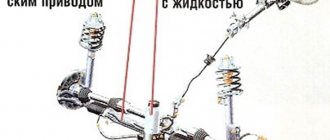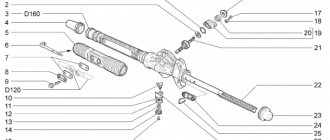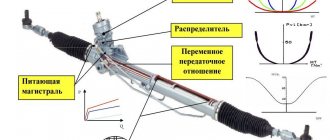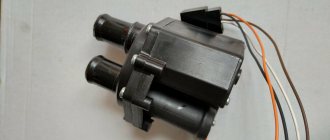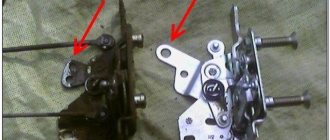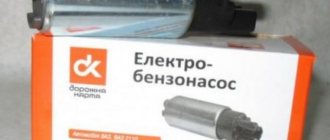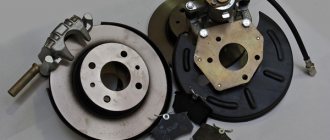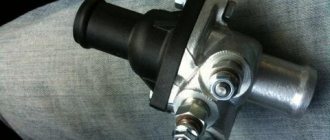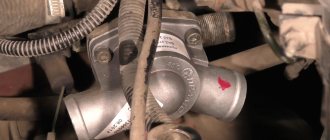We continue to get acquainted with driver assistants. The logical continuation of the hydraulic power steering is its electric counterpart. This is another power steering in a car, more advanced, according to many car owners, and reliable, according to auto mechanics. Let's figure out why this is so.
Today we’ll talk about the design and operating principle of an electric amplifier. We will discuss it and its advantages over hydraulic power steering in detail in the next article.
Why do you need electric and hydraulic power steering and what is better to choose?
Electric and hydraulic power steering in a car is a device that is needed to make it easier to turn the steering wheel when performing maneuvers. Its presence allows you to drive the car with greater comfort. The main component of the unit is the spool; its position determines the functioning of the units and elements of the system. Regardless of the type of spool movement, which can be axial or rotary, there are no differences in the principle of operation.
When the steering wheel is in the center position, the spool is held in place by centering spring elements. This ensures that oil can move freely throughout all system components. But provided that the distributor is in the correct position.
The pumping device operates in enhanced mode, dispersing the working fluid throughout the system. This unit always works, regardless of whether maneuvers are being performed or not. The main purpose of the pumping device is to pump oil.
When the driver turns the steering wheel, the spool begins to move, as a result of which the drain pipe closes. This leads to the supply of oil to one of the cavities of the cylinder, the injection procedure is carried out under the influence of pressure.
At the same time, the piston components and rod, due to the movement of fluid, rotate the wheels and the distributor housing in the direction where the spool moves. The switchgear housing can overtake the spool only at the moment when it stops moving, this indicates that the maneuver has been performed.
Then the spool element moves to its original state, and the oil drain pipe opens.
Depending on the type of hydraulic booster, its design may vary.
What kind of power steering are there?
For a long time, automobile designers did not even think about power steering servo. Low requirements for handling and comfort and a small contact patch of relatively narrow tires made it possible to manage with human power alone even in driving heavy trucks. There was only one way to reduce the effort on the steering wheel: increase the drive ratio and the diameter of the steering wheel. And the driver had to put up with the fact that the driver would have to make five or six turns of the huge steering wheel from rebound to release, and the control accuracy would be low. Power steering first appeared on heavy equipment - mining dump trucks. This happened in the late 30s, before the war. True, at first they began to use pneumatic boosters - they were simple and were powered from the compressor of existing air brakes. But hydraulics, although more complex and more expensive than pneumatics, worked quieter and more accurately. The designers of passenger cars settled on it. The skirmishers here were, of course, the Americans. In 1951, Chrysler Crown Imperial production cars were equipped for the first time with Hydraguide hydraulic boosters as standard equipment. And in Europe in 1954, the Citroen DS 19 acquired a hydraulic booster.
Types of steering gear
First, about the steering mechanisms themselves, of which there are three types on cars. One of them, well known to us from the classic Zhiguli, Muscovites and Volgas, bears the unappetizing name “worm-sector” or “worm-roller” due to the fact that its action is based on the use of a worm gear pair. A globoidal worm mounted on the end of the steering shaft turns the steering bipod through a toothed sector or roller, and it pulls the steering linkage rods to the right and left.
Such a mechanism has practically disappeared from the scene, giving way to more complex devices in the steering drives of trucks and passenger cars with a classic layout. Their full name is “screw-ball nut-rack-sector”. The screw that ends the steering shaft pushes the piston-rack along its axis through balls circulating along the thread. And he, in turn, turns the gear sector of the steering bipod.
But since the mid-70s, with the spread of front-wheel drive passenger cars, the oldest type of steering mechanism - “rack-and-pinion” or simply rack-and-pinion - began to come into fashion. Yes, yes, the oldest one - after all, on the very first cars of the late 19th century, this simple combination of a gear on the steering shaft and a rack in the turning mechanism was already used to turn the steering wheels! Designers did not forget about it in the mid-20th century - for example, BMW cars of the 30s were equipped with rack and pinion mechanisms. And then it turned out that the rack-and-pinion mechanism, being lighter and more technologically advanced than other mechanisms, is ideal for the front-wheel drive layout and McPherson suspension, providing greater ease and accuracy of steering. And now the vast majority of mechanisms on passenger cars (including classic ones) are rack and pinion. But trucks, pickups and large SUVs mostly still rely on nut-and-screw devices with recirculating balls.
The steering mechanism is of the worm-roller type. 1 - globoidal worm; 2 - double-ridge roller; 3 — bipod shaft; 4 - adjusting screw
Steering of a modern car
Steering is designed to change the direction of movement of the car by turning the front wheels. The automobile wheel appeared before our era, but turning axles appeared on horse-drawn carriages only at the beginning of the 19th century. This design was also used on the first cars. Later the steering linkage was born. In those early years, of course, no one imagined that steering would become so complex: mechanics would enter into an alliance with hydraulics and even electronics.
Power steering operation
Most modern cars are equipped with power steering - EUR and power steering. Power steering is designed for comfortable driving, as well as to reduce the force on the steering wheel and hold the car after a sharp maneuver. Today, even in the basic configuration, the car receives power steering.
Until recently, there were two options for steering mechanisms with built-in hydraulic boosters: rack and pinion and “screw-ball nut-sector”. The latter were installed on large cars and SUVs. Today, compact “racks” are increasingly appearing on heavy machines.
Let us recall the principle of operation of a rack and pinion mechanism with a hydraulic booster. In the housing there is a distribution valve with a sensitive element - a torsion bar connected to the steering shaft. The driver turns the steering wheel, the torsion bar, twisting, moves the spool. It slightly opens the holes in the oil channels leading to the power cylinder of the power steering. The latter pushes the rack, reducing the force on the steering wheel. As soon as the driver stops turning the steering wheel, the torsion bar returns to its original position, and the fluid is transferred back to the reservoir.
The performance of the pump, driven by a belt from the crankshaft, must be such that when the engine is idling, the driver can turn the steering wheel without “biting” at a speed of at least 1.5 revolutions per second. Excessive pressure releases the bypass valve.
Steering mechanisms with variable gear ratios help make steering comfortable both when parking and on the highway: in the center of the rack, the teeth are cut with a small pitch, at the ends - with a larger pitch. At small turning angles, the car does not react so sharply to steering inputs, which is very important at high speeds, but when turning, you have to turn the steering wheel less.
Servotronic
Additional comfort and safety were brought by systems that regulate steering force depending on speed. An example is “Servotronic” installed on an “Audi”.
At the top of the distributor there is a so-called reverse action chamber. A piston connected to a spool moves in it.
Let's imagine that the driver is turning right. The spool opens the path for fluid to the power cylinder, which helps the rack turn the wheels. At the same time, oil begins to flow through the solenoid valve (it is controlled by an electronic unit that receives information from the speed sensor) into the reverse-action chamber. One of the bypass valves opens, a pressure difference arises, and the piston, lowering, limits the stroke of the spool. The pressure in the power cylinder of the hydraulic booster drops, and the force on the steering wheel, on the contrary, increases. When the driver stops turning the steering wheel, the spool and check valve close.
When turning to the left, another bypass valve opens, and the piston rises, again correcting the movement of the spool, the pressure is released in another part of the power cylinder.
When parking and driving at a snail's pace (up to about 20 km/h), the solenoid valve that limits the flow of fluid into the reverse chamber is closed - the steering wheel can be turned with one finger. As the speed increases, the valve gradually opens and the force on the steering wheel increases.
The device works efficiently and reliably. But the hydraulic pump takes power from the engine, which means it consumes excess fuel and harms the environment. Such a “freeloader” is especially undesirable for low-power motors. The designers found another solution: the pressure of the working fluid is pumped by an electric pump. The control unit receives information from the steering wheel rotation and vehicle speed sensors.
Manufacturers have meticulously calculated that thanks to electro-hydraulic boosters, the car saves about 0.2 l/100 km. It is important that it is easier for engineers to select characteristics and configure the device for a specific model.
Active steering. Steering wheel with gearbox.
The next step is the so-called active steering. The main advantage is the ability to change the gear ratio between the steering wheel and wheels. On the way from the steering wheel to the power steering mechanism, a planetary gear with an electric motor is built in.
When you drive away from the pavement, the gear ratio is minimal, and the number of full turns of the steering wheel is no more than two. As the speed of the car increases, the control becomes less sensitive, and as soon as you get out on a country road, the electric motor, tightening the carrier of the planetary gearbox, will increase the gear ratio.
Active steering, in cooperation with other systems, can also help in difficult situations. For example, the car skidded. The computer, having polled the steering angle and wheel speed sensors, will turn on the electric motor. He will reduce the gear ratio to make it easier for the driver to keep the car on the desired trajectory. Active steering is also useful during emergency braking with ABS: if it is not possible to stop in time, it is easier for the driver to avoid a collision.
The first production models to use such a device were the BMW 5 Series. Probably, such systems will soon be installed on many cars, until they are replaced by the so-called drive-by-wire.
Electromechanical amplifiers
Successful attempts to displace hydraulics from steering were made at the end of the last century. Today, some cars already have electromechanical amplifiers.
The operating principles of electric and hydraulic booster are largely similar. By turning the steering wheel, the driver tightens the torsion bar, a sensitive element that sends a signal to the computer. He gives a command to the electric motor, which tightens the steering shaft, reducing the force on the steering wheel.
The widespread use of electric and hydraulic boosters is hampered by the current 12-volt standard for vehicle electrical equipment. Therefore, for now they are found only on small cars.
Control by wire
And yet, the future, apparently, does not lie in cunning mechanics or hydraulics, complicated by electronics. The greats of the automotive industry are working hard on systems without a mechanical connection between the steering wheel and wheels - the so-called steering by wire.
The rotation of the steering wheel is monitored by a special sensor. The electronic unit, receiving information about speed, lateral and vertical accelerations, sends a signal to actuators - electric motors that turn the wheels.
The advantages of such a system are obvious. In a critical situation, the car will be able to independently (and faster than a person!) turn the wheels to the desired angle. Let's say the stabilization system failed to prevent a skid, and the car spun like a top on an icy highway. Fast-acting electronics, having interrogated the sensors, will turn the steering wheel where and how much is needed, and will slow down one or a pair of wheels.
The independence of the car will make life much easier for the driver: for example, the computer will deftly park. And when cars are taught to “see” well, they will even be able to avoid obstacles.
Such systems are also technologically advantageous: stringing wires is much easier than a shaft with hinges. The steering linkage is retired - different angles of rotation of the wheels are set by the electric motors themselves. By the way, from the point of view of passive safety, this design is better.
There are already a lot of concepts without traditional controls. Apparently, production cars will appear in the foreseeable future. And then, lo and behold, the usual steering wheel will be replaced by a multifunction joystick - with it the driver will adjust not only the direction, but also the speed.
The car's steering is designed to change the angle of rotation of the wheels when the position of the steering wheel changes. In general, if the steering wheel is turned to the right, then the steering operates, which turns the car’s wheels also to the right. The greater the steering angle, the greater the angle the steering wheels turn.
The main requirement for the steering of a modern car is reliability and accuracy of operation. This means that if the steering is faulty, this can lead to dire consequences, because the car becomes completely uncontrollable. Another basic requirement is control accuracy, i.e. When turning the steering wheel, the wheels should immediately, and not with a delay, turn to a certain angle, which exactly corresponds to the angle of rotation of the steering wheel.
The steering system consists of a steering gear and a drive. At the moment, the most common types of steering mechanisms are: screw-nut, worm-roller and rack-sector. These mechanisms are mechanical, but recently the largest car manufacturers want to replace mechanical steering with electronic ones. Those. there will be no mechanical rods and drives, there will only be a control unit, which, according to changes in the position of the steering wheel, will turn the wheels of the car using electric motors
Power steering - power steering
The actuator mechanism of the power steering of a passenger car, as a rule, is made integral with the steering mechanism - such amplifiers are called integral. ATF oil is used as a working fluid in power steering of foreign cars - the same as in automatic transmissions. And domestic units operate on grade P oil, whose properties are close to the usual “spindle”.
Rack and pinion steering with hydraulic booster. If the tie rods, as here, are located on the sides of the rack, then the piston is located in the middle of the body. And if the rods are attached to the central part of the rack, as is done on Samara and Moskvich-2141, then the piston is moved to the side. 1 — steering rack; 2 - piston; 3 — oil seals; 4 — steering rod joints; 5 — distributor with spool; 6 - gear; 7 — torsion bar; 8 — rotary hydraulic pump
A rotary or axial piston pump, driven by a belt from the crankshaft, sucks oil from the reservoir and pumps it under high pressure of 50-100 atm into the spool valve. The distributor's task is to monitor the force on the steering wheel and help turn the steered wheels in a strictly dosed manner. To do this, a tracking device is used - most often it is a torsion bar built into the section of the steering shaft. When the car is stationary or driving in a straight line, there is no force on the steering shaft and the torsion bar is not twisted - accordingly, the metering channels of the distributor are blocked, and the oil is drained back into the reservoir. The driver turns the steering wheel, the wheels resist - the torsion bar twists the more strongly, the greater the force on the steering wheel. The spool opens the channels and directs oil to the actuator. In a ball-screw-type mechanism, more pressure is applied either behind or before the piston, helping it move along the steering shaft. And in a rack and pinion mechanism, oil is supplied to the rack body - in one direction or another from the piston connected to the rack, and pushes it to the right or left. When the steering wheel is already turned all the way, the safety valves are activated, relieving the oil pressure and preserving the mechanism parts from damage.
Electronics will help
An undeniable advantage of power steering is that it makes the work of your hands easier during parking maneuvers, when you have to make many turns of the steering wheel at maximum effort, or in long turns. But the amplifier has another useful property - it reduces the transmission of shocks from road unevenness to the steering wheel.
What about the disadvantages? Owners of cars with power steering often complain about the absence or lack of reactive force on the steering wheel. Alas, the hydraulic booster is most often to blame for this - it helps the driver too actively, doing him also a disservice, removing that bit of restoring force that provides the “feeling of the car.” And the task of designers when developing and tuning the chassis turns out to be damn difficult. After all, in order to achieve good information content of the steering drive and at the same time not make the steering wheel too tight, you need to link together a lot of factors: pump performance, spool parameters and torsion bar stiffness, front suspension geometry and wheel alignment angles (the magnitude of the restoring force primarily depends on this), parameters rear suspension, tire handling characteristics and even body torsional rigidity! Therefore, it is no wonder that cars that are impeccable from this point of view (for example, Peugeot 405, 306 or BMW 3 Series) are very, very rare. However, many companies deliberately sacrifice information content in favor of comfort, knowing the attachments of their clientele.
Another task facing the designers is to make sure that at low speed the steering wheel is light, and at high speed it becomes more elastic and informative. And in the German ZF Servotronic hydraulic boosters, which are installed on Audi A6 and A8 cars, BMW 5th and 7th series and all Jaguar models, an electrohydraulic pressure modulator comes to the aid of the spool - with an increase in speed, based on a signal from the control unit, it limits the pressure to working circuit, and the assistance of the hydraulic booster comes to naught. There is another solution - to drive the power steering pump not from the engine crankshaft, but from an electric motor. Then, using electronics, changing the rotation speed of the electric drive, you can vary the pump performance as desired. This scheme is used in hydraulic boosters of Mercedes-Benz A-class cars. True, the tempting idea of turning off the pump altogether in a straight line in order to save fuel (it takes several horsepower to drive the hydraulic pump) is not feasible in practice - if the steering wheel is sharply deflected, the pressure will not have time to increase so quickly, and the steering wheel may “bite”.
Electric power steering - EUR
These are electric boosters with no hydraulics left in them! There is a sensor on the torsion bar of the tracking device, and depending on its signal, the electronics supplies a current of the required polarity and strength to the windings of the electric motor connected to the steering mechanism through a worm gear. And using signals from the speed sensor, you can change the characteristics of the amplifier in accordance with any dependence stored in the unit’s memory. The advantages of an electric amplifier are obvious:
— independence of the operation of the power steering from the vehicle engine speed, — information content (self-tuning of the power steering to the vehicle speed), — independence of the operation of the power steering from temperature changes, — efficiency:
a) power steering consumes energy only when the steering wheel is rotated, in contrast to the hydraulic booster, when the working fluid is always driven through the pipes, which consumes additional energy.
b) The efficiency of the electric motor is much higher than the efficiency of the hydraulic pump.
— reliability (no hoses, belts, gaskets, seals, fluids), — does not require maintenance (replacement, topping up of working fluid), — the symmetry of the steering wheel is an order of magnitude higher (no difference in rotational force in left and right rotation of the steering wheel)
Option for small cars - the amplifier is built into the steering column
Option for middle class cars
Option for large class cars and minibuses - electric power amplifier is integrated with the steering rack
Depending on the total weight and layout of the vehicle, the ZF Servolectric electric power steering can be integrated into various steering links.
1 — steering column; 2 — electric booster with a worm gear and an electronic control unit; 3 - intermediate shaft; 4 — rack and pinion steering mechanism; 5 — tracking device with torsion bar; 6 — control unit; 7 - electric drive with a screw-ball nut-rack mechanism
Variable ratio steering
Is it possible to change the gear ratio as well? After all, near the zero position of the steering wheel, when you are driving in a straight line at high speed, excessive sharpness of the steering does not bring any good, forcing the driver to strain. And when parking or turning, on the contrary, I would like to have a smaller gear ratio - in order to turn the steering wheel to the smallest possible angle. For this purpose, there are several schemes of rack and pinion steering mechanisms.
This is how the ZF variable ratio rack and pinion steering mechanism works. Here the profile of the rack teeth and the engagement arm change
Honda VGR (Variable Gear Ratio) rack and pinion steering mechanism was used on Honda NSX cars
ZF uses rack teeth with a variable profile: in the near-zero zone the teeth are triangular, and closer to the edges they are trapezoidal. The gear meshes with them with a different shoulder, which helps to slightly change the gear ratio. And another, more complex option was used by Honda on its NSX supercar - by the way, in combination with an electric booster. Here the rack and pinion teeth are made with variable pitch, profile and curvature. True, the gear has to be moved up and down, but the gear ratio can be varied over a much wider range. Honda has demonstrated a different approach. Imagine two racks mounted coaxially inside each other and connected through a worm drive to an electric motor. One rack, as usual, is rotated by the steering shaft gear, and the other is connected to the steering rods. Based on a signal from the control unit, the electric motor moves the driven rack to the right or left of the driving one - and the wheels turn to a larger angle.
Steering development process
If we look at the concept cars that are exhibited at international exhibitions, we can see that the steering philosophy is taking a new path. These cars do not have a steering wheel as such. There is a joystick, like on game consoles, and a smart computer controls the car. But this is still, albeit not far away, but the future. What is the situation now? Let's walk through the evolution of steering.
The oldest steering mechanism, but still in use today, is the worm-roller combination. A worm with a variable diameter is connected directly to the steering shaft. It transmits torque to a roller, which is connected to a shaft with a bipod. Such a steering mechanism is capable of withstanding heavy loads, turning the wheels at a large angle, and practically does not transfer impacts from the wheels to the steering wheel. But this design is too complicated, the steering wheel is not very informative and will constantly torment you with backlashes.
It was replaced by a rack and pinion steering mechanism. This mechanism is the most popular today. It is designed very simply. The gear, which is connected to the steering wheel, moves a rack with teeth, which, in turn, turns the wheels.
The next step in the development of steering was the problem of easing the effort on the steering wheel on the driver's side. There are three types of booster, hydraulic, electro-hydraulic and electric. The hydraulic booster has a piston, on the right and left sides of which there is liquid under constant pressure, which is maintained by a pump driven by the engine. There is also a spool, which, in response to steering wheel rotation, closes a certain channel to help turn the steering wheel. The disadvantage of such a device is the pump, which can only work when the engine is turned on. This drawback has been eliminated in the electric hydraulic booster. In it, the pump to create pressure is driven by an electric motor, which can be powered by a battery, which means when the engine is turned off. This approach allows you to remove the load from the engine, thereby providing additional horsepower for movement. There is no piston in the electric booster. Here the electric motor is directly connected to the steering rack. The advantage of such a system is that there is no liquid here, which means there are no leaks. In addition, this design is quite compact.
And that is not all. Already now, some cars, in particular BMWs, have an active steering system installed - Active Steering. It allows you to change the steering gear ratio. For example, when you are driving on a highway, the steering wheel should be sensitive, but when parking, you would like to turn the steering wheel less.
Steering technology is already being introduced, which itself, with the help of numerous electronic sensors and a smart on-board computer, parks the car. You don't even need to steer - the car will do everything for you.
The inquisitive minds of our time come up with outlandish technologies every day that could only recently be read on the pages of science fiction. It is even difficult to imagine what the level of development will be in the next half century. But now we can see the pace at which the automotive industry is developing.
Power steering diagram and power steering maintenance
Power steering is increasingly being installed on passenger cars. It, of course, makes it easier to control, but what to do when the hydraulic booster fails? This shouldn't cause much concern.
A person always strives to get the maximum return with a minimum of effort. At first he became too lazy to walk - and a car appeared. Soon, “hardworking” humanity discovered with horror that even turning the steering wheel requires a lot of effort. And I thought about how to alleviate my difficult fate... In 1925 in the USA, Francis Davis was one of the first to patent a hydraulic power steering, and in 1933 General Motors already intended to install it on its Cadillac car with a V12 engine.
As the name suggests, this device is based on the principle of hydraulics. The pressure in the system, filled with a special fluid, is created by a hydraulic pump driven by the engine crankshaft. The design includes a spool valve, which, when turning the steering wheel, switches the supply of fluid to one or another cavity, providing an additional steering mechanism (gearbox or rack).
The goal is to make the steering wheel turn light enough when maneuvering at low speeds and more noticeably on the steering wheel when driving at higher speeds, so that driving is as safe as possible.
For most hydraulic boosters, regardless of the speed of the vehicle, the gain remains constant. However, an increasing number of vehicles entering the market today are equipped with variable gain systems, in which the degree of gain already changes depending on the speed of the vehicle. They provide precise and fast response when the vehicle is cornering and the required effort when maneuvering the vehicle at low speeds. One way to achieve this is to use a steering rack with a variable gear ratio. For this purpose, the pitch and diameter of the pitch circle of the teeth change along the length of the rack, while on the gear the pitch of the teeth remains constant. When the wheels of the car are set to move in the forward direction, the steering gear ratio is equal to one and the gain coefficient is the smallest, but as the steering wheel approaches its extreme positions, the gear ratio increases and the gain required to turn the wheels decreases. The computer-controlled power steering also ceases to be something unusual. Such steering systems process information from the car's speedometer. Their work is determined not only by the number of engine revolutions, but also by the speed of the vehicle. The computer microprocessor analyzes the signals received from the sensor and calculates the required gain at each moment, which is implemented using an electro-hydraulic converter. The idea of the developers of such systems is to take the best of two types of steering - at speeds typical for parking a car, make the steering the lightest, and when driving at high speeds, reduce the effect of the amplifier to such an extent that the system works almost the same as a conventional mechanical one steering without power assistance.
As a rule, the power steering mechanism is highly reliable and does not require complex maintenance during vehicle operation. Even if the power steering pump fails, you can continue driving the car, although turning the steering wheel in this case will require significantly more effort than even in a car without power steering.
The cause of complete failure of the hydraulic booster is most often a break in the pump drive belt. Check the condition of the belt regularly - it may be worn out or loose. One of the signs of weak belt tension is the appearance of a kickback (reverse shock) on the steering wheel. This is usually most noticeable when the car is moving away, when the wheels are turned to full.
Maintain the correct amount of fluid in the amplifier reservoir. If necessary, add only the brand of fluid specified in the service manual. Please note that hydraulic fluid designed for automatic transmissions cannot be used for all power steering systems. There are many different brands of liquids available on the market. The wrong fluid can ruin all the seals in the system.
Since the fluid is used not only as the working fluid of the hydraulic system, but also as a lubricant, it is very important that its level does not fall below normal, otherwise the pump may fail. Also make sure the liquid is clean. Dirty or expired fluid will quickly destroy the pump and hydraulic system seals located on the rack and pinion mechanism, which will then require expensive repairs. Changing the fluid is rarely required (check your vehicle's owner's manual to see if this is part of your periodic maintenance. It usually isn't). If you want to drain the fluid, you need to open the expansion tank cap, disconnect one of the system pipelines and turn the steering wheel from side to side several times to squeeze fluid out of the hydraulic system. There is usually no special hole for draining liquid. New fluid is refilled through the expansion tank. As a rule, in this case, air pockets form in the hydraulic system, impairing its performance. They should be removed. The easiest way to do this is as follows. Start the engine, open the expansion tank cap and bleed the system by turning the steering wheel several times from one extreme position to another. As the hydraulic system is pumped, the fluid level in the reservoir will decrease. Repeat the procedure until it stabilizes. After this, add liquid to the required level and close the lid, first checking to see if the ventilation hole in it (if any) is clogged.
The most common malfunction of hydraulic boosters is fluid leakage. Cars with this defect usually fail to pass the annual inspection. Some older hydraulic systems allowed a small amount of fluid to leak through bearings, shafts, etc., because they were nearly impossible to make completely sealed. Regularly inspect system components from all sides for timely detection of possible leaks from pipelines and fittings, as well as from loose pipelines and other parts.
Find out if tubes and hoses are rubbing against chassis and suspension parts. A malfunction of the hydraulic drive can lead to fluid breakthrough through the covers. When checking, turn the steering wheel from one extreme position to another. Small leaks can often be repaired by adding special sealing additives, which are commercially available, into the fluid. However, this will only be a short-term measure. If the pump malfunctions, it can be repaired using a repair kit of new seals. Replacing the seals won't do much if the pump is badly worn.
For those who like to do everything themselves, repairing the pump will not present much difficulty. However, before installing a repaired pump on a car, it is advisable to test it on a stand. If you suspect that the pump is worn out, contact a power steering specialist to check its operating pressure and correctly determine the problem.
Generally speaking, the numerous advantages of a power steering system many times outweigh the problems created by its possible malfunctions. After you have driven a car with a modern system, you should change to a car that does not have a power steering system, and you will immediately “feel the difference”
Material from the website "Center Key"
The device of a classic power steering (power steering)
- Pump mechanism.
This unit is designed to provide the entire system with the necessary pressure so that the liquid circulates. Most modern cars use plate mechanisms. This is due to increased efficiency and increased service life. The pump itself is usually mounted on the engine, and its operation is ensured by a belt drive. - Distribution unit.
This mechanism is used to distribute oil and direct it to specific cavities in the cylinder. Depending on the system, the power steering may use a rotary or axial distribution mechanism. If the spool movements are translational, the distribution unit is equipped with an axial distributor, while the rotational movements are equipped with a rotary distributor. The assembly is installed on steering gear components or directly on the steering shaft. This mechanism is sensitive to the presence of contaminants in the working fluid. - Hydraulic cylinder.
Used to ensure the operation of the piston and rod when supplying liquid. Special levers are used to turn the wheels of the machine. The cylinder itself is located between the body and the drive or on the steering mechanism. - Highways.
Oil moves through the pipes in the power steering system. The lines can be low or high pressure. The first ones are used to return the working fluid from the expansion tank to the pumping device and again to the tank after working out. The second ones are designed to supply consumables between the pumping device, the distribution mechanism and the cylinder. - Oil.
The lubricant is necessary to ensure the supply of force to the hydraulic cylinder from the pumping device. It helps lubricate all components of the amplifier. - Expansion tank.
The tank is designed to store consumables and circulate them. It is equipped with a filter device, through which dirt is removed from the substance. There are marks on the tank that allow you to control the liquid level.
Electrohydraulic power steering
EGUR is a variant of the classic hydraulic booster. It differs in that the high-pressure pump is rotated by its own electric motor, and not from the crankshaft of the car engine. All other elements - distribution and actuator mechanisms, hydraulic lines - have remained virtually unchanged.
In the electric power steering unit, the electric motor with the control unit, the pump and the oil tank are combined into a single module.
Many Renault, Nissan and GM models are equipped with electro-hydraulic boosters.
How does electric power steering (EPS) work?
There is no working fluid in the EUR system.
The electric booster does not always function, but only when performing maneuvers. The power unit of the system provides torque, determined by the torque on the steering unit. This parameter is measured by a special controller that transmits information to the system control module. The block is designed to calculate the required activation power parameter of the system motor, taking into account the position of the steering wheel. The steering angle measurement procedure is performed using a controller built into a switch mounted under the steering wheel. The rotor device of the electric motor has a controller that measures the rotation speed of the mechanism, after which it transmits the data to the computer. This is required for the module to determine the scrolling speed of the node. The EUR control module takes into account many readings when calculating the required force on the electric motor.
This parameter is determined:
- The value of the steering moment;
- Vehicle speed;
- The revolutions of the power unit, the angle and speed of the steering wheel.
Subsequently, the force from the motor is supplied to the rack through the drive gear, as well as a worm gear.
The movement of the rack is carried out as a result of several forces. This is facilitated by the steering wheel, as well as the electric motor of the power steering system, which is controlled by an electronic module. When you move the steering wheel, the torsion bar twists. The applied force is calculated by the electronic module in accordance with the change in the position of the constituent elements of the controller. The steering mechanism determines the deflection of the steering wheel. These parameters are processed by a microprocessor module that interacts with the machine's ECU.
Taking this information into account, the microprocessor unit calculates the required force, after which it supplies power of the required value to the motor. The latter moves the steering shaft or rack.
Design features, operating principle
Today, there are two types of layout of this unit. In the first case, the force of the electric motor is transmitted to the rack. In the second - on the steering wheel shaft. The most popular is the first type of electric amplifiers. It is also called electromechanical. The design uses two gears with parallel drive.
The EUR is combined in one block with the steering mechanism. Electric motor type – asynchronous. How does this mechanism work? Torque is transmitted directly to the rack from the electric motor. There are also two sections of teeth on the rack and pinion mechanism.
The EUR system consists of many sensors. These include a steering angle element, a torque sensor, crankshaft speed and the speed of the vehicle itself. The mechanism closely interacts with the ABS control unit and the vehicle's ECU.
After processing information from the above sensors, the embedded program generates a corresponding signal to the actuator. It is an asynchronous electric motor.
EPS (electric power steering) device
Main components of the system:
- Electric motor; most machines use brushless motors.
- Servo. Different types of devices can be used.
- Torque detection controller. This sensor is considered one of the main ones; it is usually mounted on a torsion bar located in a section of the steering shaft. Two different controller parts are installed at the ends of the element. Depending on the type of power steering, the sensor may belong to the class of optical or magnetic.
- Steering wheel movement controller.
- Control module.
- Some cars are equipped with a steering wheel speed controller.
Which is better: electric or power steering?
To understand which is better, we suggest that you familiarize yourself with the list of disadvantages of both systems. Disadvantages of power steering and electric power steering
| Cons of power steering (power steering) | Cons of EPS (electric power steering) |
| In cars equipped with power steering, it is not allowed to hold the steering wheel in its extreme position for a long time. This will lead to overheating of the working fluid and damage to structural elements, primarily the pump. | The EUR cannot boast of highly informative steering |
| The power steering should be serviced from time to time. Once every few years, the working fluid needs to be replaced. The consumer must regularly monitor its level, diagnose the integrity of electrical circuits, lines and the pumping device | The likelihood of failures in the EUR settings. Possible damage to the steering wheel or shaft controllers |
| The operation of the amplifier is directly related to the power unit. The pumping device takes part of the power from the power unit. When driving straight this power is wasted | Possibility of crashes while driving. If the amplifier becomes blocked, it can lead to its breakdown and an emergency situation on the road. Aligning the wheels if the car is stationary will be problematic |
| Power steering does not allow adjustment of operating modes taking into account driving conditions | The electrical component is often beyond repair. It is better not to repair the steering wheel position controllers, but to replace them, since when re-soldering the sensors, the consumer may set the wrong parameters. Because of this, servicing the EUR will be more expensive. |
| Power steering ensures highly informative operation of the entire system when driving at low speeds. But when driving at high engine speeds, this parameter drops | Controllers require periodic calibration. It is problematic to do this on your own; you will have to contact qualified specialists. |
Power steering is easier to maintain, but its operation takes away some of the engine power of the car.
Source
